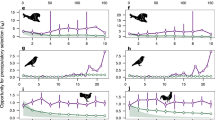Abstract
This paper is the first to integrate both field and theoretical approaches to demonstrate that fertility benefits can be a direct benefit to females mating on the classical lek. Field data collected for male sharp-tailed grouse (Tympanuchus phasianellus), a classical lekking species, revealed potential fertility benefits for selective females. Adult males and individuals occupying centrally located territories on the lek were found to have significantly larger testes than juveniles and peripheral individuals. Further, using empirical data from previously published studies of classical lekking grouse species, time-series analysis was employed to illustrate that female mating patterns, seasonal and daily, were non-random. We are the first to show that these patterns coincide with times when male fertility is at its peak.
Similar content being viewed by others
Author information
Authors and Affiliations
Additional information
Received: 26 February 1999 / Revised: 13 December 1999 / Accepted: 15 March 2000
Rights and permissions
About this article
Cite this article
Tsuji, L., DeIuliis, G., Hansell, R. et al. Non-random mating in classical lekking grouse species: seasonal and diurnal trends. Int J Biometeorol 44, 134–140 (2000). https://doi.org/10.1007/s004840000057
Issue Date:
DOI: https://doi.org/10.1007/s004840000057




